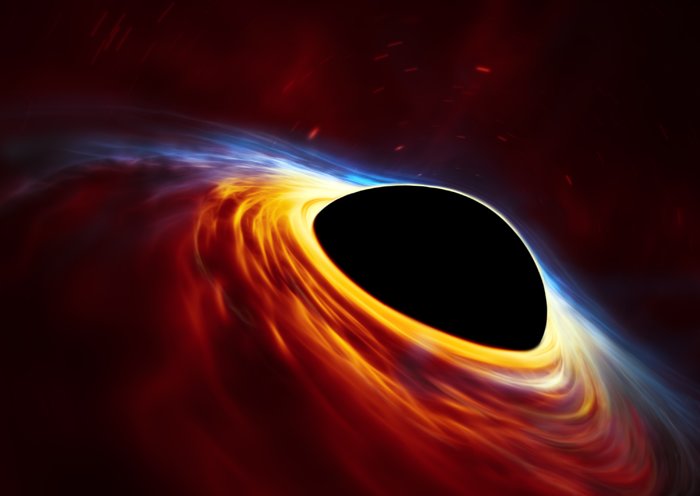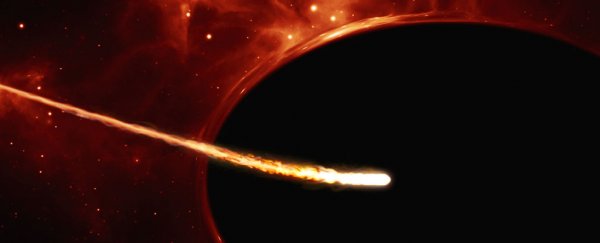In June last year, astronomers witnessed a brilliant cosmic flash thought to be the most powerful supernova on record – an explosion of intense brightness that at its peak was 20 times brighter than the total light output of the entire Milky Way.
But new observations suggest that this freak cosmic event – called ASASSN–15lh – wasn't a supernova after all, but something even rarer: the death throes of a star that came too close to a supermassive black hole, and was torn apart by it.
Ordinarily, when a star with enough mass reaches the end of its natural life, it becomes a supernova, caused by either running out of fuel or accumulating too much matter.
These are the biggest explosions in space, so ASASSN–15lh's extreme luminosity – twice as bright as the previous record holder – fascinated the space community.
But of course, stars – like people – only reach the end of their natural lifespan if something else doesn't happen to them along the way, and that's what seems to have happened to the star at the heart of ASASSN–15lh, according to a team led by astronomer Giorgos Leloudas from the Weizmann Institute of Science in Israel.
 This thin disc of rotating material consists of the leftovers of a Sun-like star which was ripped apart by the tidal forces of the black hole. Credit: ESO, ESA/Hubble, M. Kornmesser
This thin disc of rotating material consists of the leftovers of a Sun-like star which was ripped apart by the tidal forces of the black hole. Credit: ESO, ESA/Hubble, M. Kornmesser
"We observed the source for 10 months following the event and have concluded that the explanation is unlikely to lie with an extraordinarily bright supernova," says Leloudas.
"Our results indicate that the event was probably caused by a rapidly spinning supermassive black hole as it destroyed a low-mass star."
ASASSN–15lh took place in a galaxy some 4 billion light-years from Earth, and the team's hypothesis is that a supermassive black hole lies at the heart of that distant star system, which somehow drew in a nearby star.
When a star gets too close to a black hole like this, it gets pulled apart in what's known as a tidal disruption event, where extreme tidal forces stretch matter into long thin shapes – a process called spaghettification.
But for it to have destroyed a star like this, the ASASSN–15lh black hole – with a mass at least 100 million times that of the Sun – would have to be no ordinary black hole.
"The tidal disruption event we propose cannot be explained with a non-spinning supermassive black hole," says one of the team, Nicholas Stone from Columbia University.
"We argue that ASASSN–15lh was a tidal disruption event arising from a very particular kind of black hole."
That's because non-spinning black holes can't affect stars beyond their event horizon – the boundary of their inescapable gravitational pull. But a kind of spinning black hole, called Kerr black holes, don't have that limitation.
If the hypothesis is correct, and that's really what happened here, the intense light of ASASSN–15lh resulted from the star being pulled in towards the black hole.

As this happens, the spaghettified matter within the star would collide with itself and generate intense heat, producing the intense burst of light that scientists originally took for a particularly brilliant supernova.
While the researchers acknowledge that it's just a hypothesis at this point, observations made using the European Southern Observatory's (ESO) Very Large Telescope and New Technology Telescope – in addition to the Hubble Space Telescope – reveal the presence of ultraviolet light and heat emanating from the distant galaxy, making a supernova unlikely.
There's also the question of the relatively dormant space habitat where ASASSN–15lh occurred to consider.
"We've always found supernovae in very blue galaxies, which are star-forming galaxies full of young and massive stars like the ones you expect to explode," Leloudas told Ian Sample at The Guardian.
"This is a red and dead galaxy, and very massive, where you don't expect to find any stars that will give supernova explosions. That's strong evidence against a supernova."
But while the tidal disruption angle may kill the thrill of having observed the "brightest supernova on record", now that we know, or at least suspect, that it never actually happened, the researchers say we have a whole new reason to get excited.
Especially since this would only be about the 10th tidal disruption event we know about – and the first time scientists have used the phenomena to estimate the spin of a supermassive black hole.
"This is like discovering a new kind of dinosaur," one of the team, Andy Howell from the University of California Santa Barbara, told Jay Bennett at Popular Mechanics.
"Now that we have the right tools and know what to look for, we're going to find more and get a better sense of the population. It is so exciting to have new ways of learning about black holes and stellar death!"
The findings are reported in Nature Astronomy.
